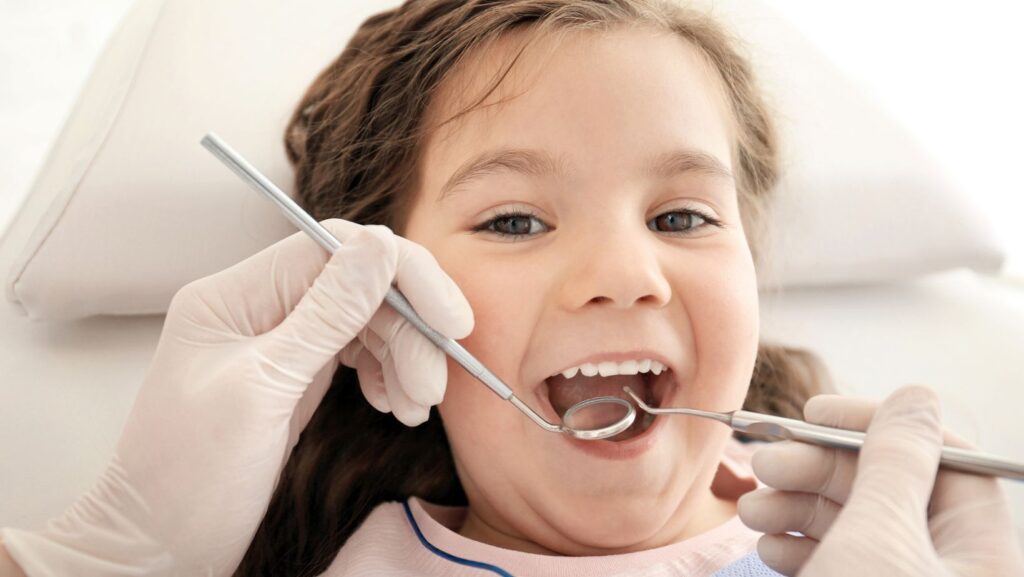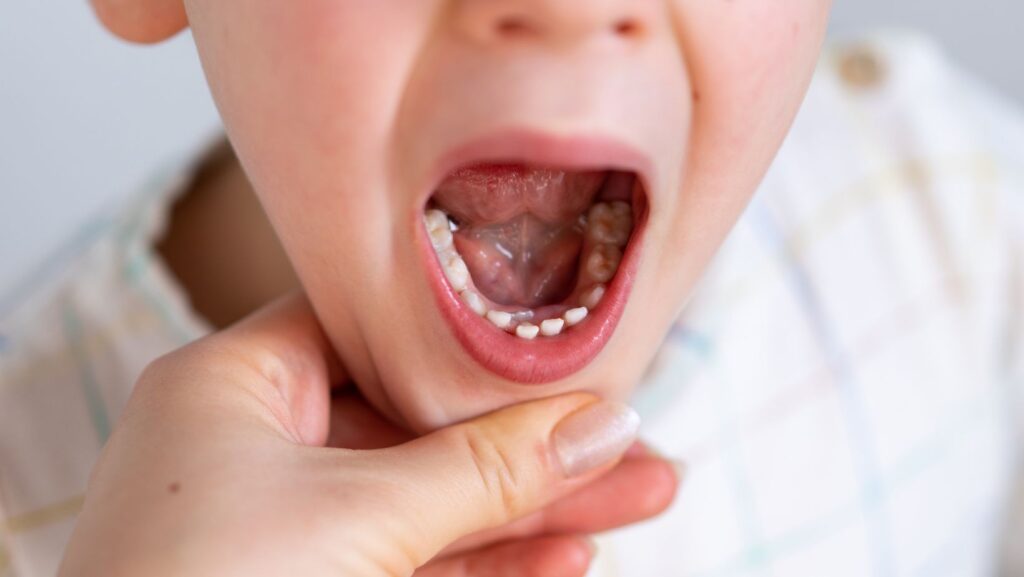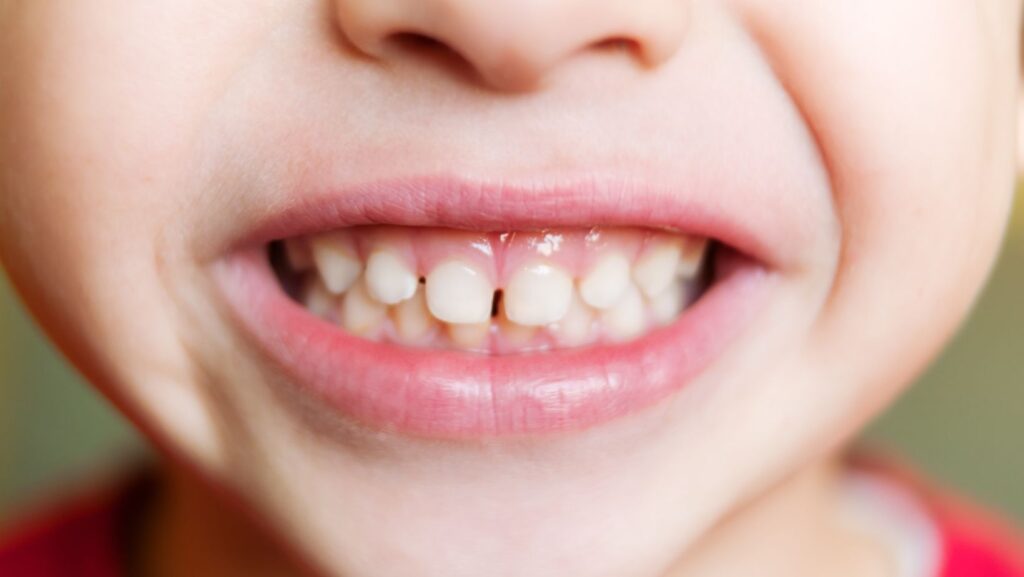Kids don’t get cavities just because they like treats—they get them when sugar + acid + time stack up. The longer teeth sit in a sugary or acidic environment, the more enamel softens. Below is a clear, parent-friendly guide to the worst offenders, easy swaps that still feel like “treats,” and a simple routine that keeps smiles healthy.
Key idea: It’s the frequency of sugary/acidic hits (constant sipping and grazing), not just the total amount, that drives decay.
Why Foods Matter: “Acid Attacks” Explained
After sugary or starchy foods, mouth bacteria make acids that soften enamel for about 20–30 minutes. Frequent snacks reset the clock over and over. Acidic drinks (sodas, sports/energy drinks, citrus juices) can erode enamel even without sugar. Saliva buffers acids, but kids who sip all day never give saliva a chance to help.
The Worst Offenders For Kids’ Teeth
1) Sticky, long-lasting sweets
- Fruit snacks, gummies, taffy, caramels, dried fruit (raisins, fruit leathers) cling to grooves and keep sugar on teeth for a long time.
- Better: chocolate (melts/clears faster), fresh fruit, or a treat with a meal instead of between meals.
2) Sour candies & acidic treats
- Sour gummies/hard candies are both sugary and acidic, a double hit to enamel.
- Better: occasional plain chocolate or a small dessert with meals; rinse with water afterward.

3) Sugary drinks (including “healthy-sounding” ones)
- Soda, sports/energy drinks, sweet teas, juice, flavored milks bathe teeth in sugar. Juice is still sugar water—even 100% juice.
- Better: water (ideally fluoridated) as the default. If serving juice, keep it small (4–6 oz with a meal) and then water.
4) All-day sipping & sippy cups
- Constant grazing/sipping (even milk or diluted juice) means constant acid attacks.
- Better: offer drinks with meals, water between. Avoid sending kids to bed with any drink except water.
5) Starchy “snack foods”
- Crackers, chips, pretzels break down into fermentable carbs that stick in grooves and feed cavity-causing bacteria.
- Better: cheese, nuts/seeds (age-appropriate), yogurt without added sugar, crunchy veggies, popcorn (for older kids).
6) “Sneaky sugar” foods
- Granola bars, flavored yogurts, breakfast cereals, sauces (ketchup, BBQ) often pack sugar.
- Better: read labels (see “Tips at the table” below); pick low-added-sugar options.
Smart Swaps Kids Actually Accept
- Drinks: Water → the default. Keep cold water bottles handy. Save juice for rare treats; avoid sports drinks unless truly needed for prolonged sports.
- Treats: Prefer chocolate over sticky candies; pair sweets with meals; rinse with water after.
- Snacks: Cheese sticks, plain or low-sugar yogurt, nuts/seeds (when appropriate), apples, carrots, cucumbers, hummus with pita, hard-boiled eggs.
- Lunchbox wins: Whole fruit (not fruit cups in syrup), mini cheese + whole-grain crackers (served with a meal), yogurt without added sugar + berries.
Tips At The Table (And In The Grocery Aisle)
- Watch sugar aliases: sucrose, glucose, fructose, corn syrup, maltose, dextrose, cane juice, honey, agave.
- Look for “added sugars” on labels and aim low.
- Time treats with meals (more saliva, less frequent exposure).
- Rinse now, brush later: after acids, have kids rinse with water and wait ~30 minutes before brushing softened enamel.
- Bedtime rule: after the nighttime brush/floss, only water until morning.
Age-Specific Guidance
- Toddlers (1–3): Avoid bottles/sippy cups in bed; limit juice; introduce open/straw cups early; brush for them twice daily.
- School-age (4–9): Pack water + tooth-friendly snacks; teach to swish with water after treats.
- Tweens/teens: Watch sports/energy drinks; mouthguards for sports; keep sugar exposures to set snack/meal times.
Daily Routine That Actually Works
- Brush 2×/day for 2 minutes with fluoride or hydroxyapatite toothpaste (pea-sized for kids who can spit; a smear/rice-sized for toddlers).
- Clean between teeth daily (floss picks can help little hands).
- Nighttime is the “golden clean”—then only water.
- See a dentist every 6 months (or as advised) for exams, cleanings, and sealants on deep grooves.
When To Call A Dentist (And Who Else Can Help)
- White spots, sensitivity to sweet/cold, food packing, or ongoing bad breath can be early signs of trouble—schedule a checkup.
- For families in the DC area, our team provides preventive and restorative care tailored to kids and parents alike. Book a visit with a Cosmetic Dentist In DC and we’ll make a plan that fits your child’s routine.
- If you need a pediatrician’s perspective on nutrition, growth, and overall health, Happy Hearts Pediatrics in Gilbert, AZ shares kid-first guidance families love. They offer nationwide Telehealth.
Emergency rule: Go to the ER for trouble breathing/swallowing, rapidly spreading facial swelling, uncontrolled bleeding, or major facial trauma.
Quick FAQ
Is juice okay if it’s 100%?
Small amounts with a meal are okay; water should be the default. All-day sipping is the problem.
Are gummies “fruit”?
No—most “fruit snacks” and gummy vitamins are sticky sugar that cling to teeth.
Are sports drinks safer than soda?
Not for teeth. They’re acidic and often sugary—treat them like sweets.
What’s one change that helps most?
Switch to water between meals and keep treats with meals, not between.

Closing Thought
You don’t have to ban every treat. Just bundle sweets with meals, choose water between, and build a rock-solid nighttime routine. Those small, boring habits are how kids keep strong enamel and healthy smiles.

